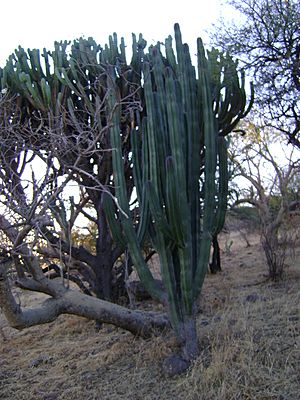Stenocereus montanus facts for kids
Stenocereus montanus, also known as the sahuira cactus, is a tall, pillar-shaped cactus. It belongs to the Cactaceae family, which includes all cacti. This special cactus grows only in Mexico, from the state of Sonora down to Colima.
Quick facts for kids Stenocereus montanus |
|
|---|---|
 |
|
| Stenocereus montanus near Calvillo, Aguascalientes | |
| Scientific classification | |
| Genus: |
Stenocereus
|
| Species: |
montanus
|
| Synonyms | |
|
Glandulicereus montanus (Britton & Rose) Guiggi |
|
Contents
Discovering the Sahuira Cactus
The sahuira cactus is a fascinating plant found in the dry regions of Mexico. Its unique shape and important role in its ecosystem make it stand out. It's a great example of how plants adapt to tough environments.
What the Sahuira Looks Like
The sahuira cactus can grow very tall, reaching up to 7 meters (about 23 feet) high. Imagine a cactus as tall as a two-story building! It has a smooth main stem, or trunk, that supports its height. Its columnar shape helps it store water.
Where the Sahuira Cactus Lives
This cactus is native to Mexico. This means it naturally grows there and nowhere else in the world. You can find it in various Mexican states, stretching from Sonora in the north to Colima in the south. It thrives in warm, dry climates.
Flowers and Fruits
The sahuira cactus produces beautiful flowers. These flowers are pollinated by bats. Bats visit the flowers at night, helping the cactus make seeds. After pollination, the cactus grows fruits.
The Sahuira's Tasty Fruits
The fruits of the sahuira cactus can be orange, red, or white. They are a tasty treat for many animals. Birds and bats especially enjoy eating them. People also like the flavor of these fruits very much.
Life Cycle and Reproduction
The sahuira cactus reproduces through its flowers and fruits. Bats help carry pollen from one flower to another. This process allows the cactus to create seeds. These seeds can then grow into new sahuira plants. This cycle helps the species continue to thrive in its natural habitat.
See also
 In Spanish: Stenocereus montanus para niños
In Spanish: Stenocereus montanus para niños

